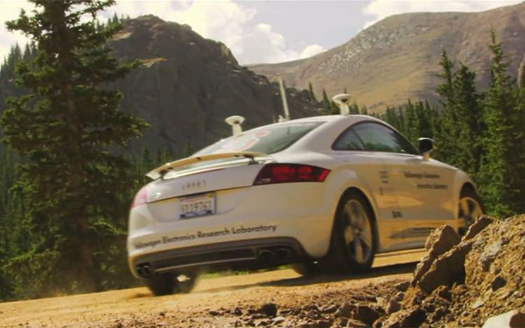

When it comes to artificial intelligence Google has a head start, what with all that free data we give them every time we search for a 30 Rock clip. So perhaps it’s no surprise that the search giant is the latest enterprise to pursue a future where cars drive themselves via complex, decision-making artificial intelligence software. Over the weekend it was revealed that Google has seven test cars that have driven 1,000 miles each without any human intervention whatsoever.
Of course, the cars aren’t exactly driverless. There is always someone sitting behind the wheel, ready to seize control should something go awry. There’s also a passenger, a technician to monitor the navigation system and ensure the software is running smoothly. But the cars do pretty much all of the work – one of them even negotiated San Francisco’s famously treacherous Lombard Street (that steep stretch of pavement that’s more or less a series of sharp switchbacks). If you count up all the miles that required only occasional human intervention, the cars have logged some 140,000 miles altogether.
The cars are years from commercialization and mass production obviously, but Google’s effort is just the latest in a series of attempts to create safer, more efficient passenger vehicles that move people around autonomously. An Italian team is currently en route from Italy to Shanghai in a pair of electric-powered driverless vans, and DARPA’s Grand Challenge has produced a handful of promising software and vehicle designs.
In fact, the Stanford Professor behind the team that won the second DARPA Grand Challenge with the Stanley robot car is the brainpower behind Google’ fleet of artificially intelligent automobiles (he’s also a Google engineer). That fleet is made up of six Toyota Priuses and one Audi TT.
The idea behind all of this, of course, is to make roadways safer and reduce energy costs. A fleet of shared smart vehicles means cars could be summoned only when they are needed rather than being owned (and parked) by each individual. Robot drivers also react faster than humans – who are increasingly distracted by a growing cacophony of technological noise in our cabs – have 360-degree vision, and remain sober and alert even after weddings and football games. And if roadways were packed with automated, networked robo-cars rather than angry, lane-weaving, stop-and-go drivers, traffic would move more efficiently as well.
Ambitious predictions say self-driving autos could be deployed in the next eight years. Getting them certified for the road and brought within the letter of the law is going to cause unenviable headaches along the way, but the end result could be a complete re-engineering of car culture beginning before the decade is out.
